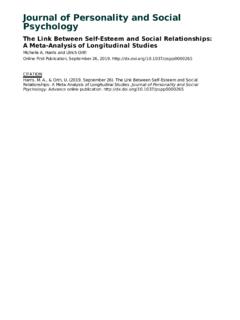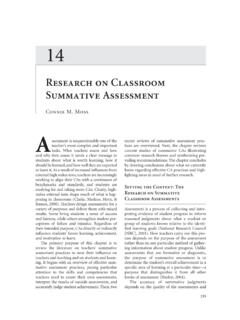Transcription of Disability and the Education System
1 Disability and the Education System Disability and the Education System Laudan Aron and Pamela Loprest Summary Education is important for all children, but even more so for children with disabilities, whose social and economic opportunities may be limited. In this article, Laudan Aron and Pamela Loprest assess how well the nation's Education System is serving students with disabilities. Aron and Loprest trace the evolution of the special Education System in the United States from its origins in the civil rights movement of the mid-twentieth century. They note the dual char- acter of federal legislation, which both guarantees eligible children with disabilities the right to a free, appropriate public Education in the least restrictive setting and establishes a federal funding program to help meet this goal. They then review the types of services and accommo- dations these children receive from infancy through young adulthood.
2 The special Education System has given children with disabilities much greater access to public Education , established an infrastructure for educating them, helped with the earlier identifica- tion of disabilities, and promoted greater inclusion of these children alongside their nondisabled peers. Despite these advances, many problems remain, including the over- and underidentifica- tion of certain subgroups of students, delays in identifying and serving students, and bureau- cratic, regulatory, and financial barriers that complicate the program for everyone involved. More important, the authors show that special Education students still lag behind their nondis- abled peers in educational achievements, are often held to lower expectations, are less likely to take the full academic curriculum in high school, and are more likely to drop out of school.
3 Only limited evidence is available on the effectiveness of specific special Education services or on how to improve student achievement for this important subgroup of students. Improving the System will require better ways of understanding and measuring both ends of the special Education continuum, namely, what services special Education children need and receive, and what academic outcomes these students achieve. Without stronger evidence linking these two aspects of the System , Aron and Loprest argue, researchers will be unable to gauge the efficacy of the services now being delivered or to formulate effective reforms to the System as a whole. Laudan Aron is a senior program officer in the Division of Behavioral and Social Sciences and Education at the National Research Coun- cil in Washington, Pamela Loprest is director of the Income and Benefits Policy Center at the Urban Institute in Washington, VOL.
4 22 / NO. 1 / S PR ING 2012 97. I. Laudan Aron and Pamela Loprest t is difficult to overstate the impor- highlight the dual nature of the law, which tance of the nation's Education both defines civil rights for a class of pro- System for children with disabilities tected persons and establishes a funding and their families. Education is stream for programs and services to support important for all children, of course, these persons. but for those with disabilities or special needs it can mean the difference between a We then present basic information profil- socially fulfilling, intellectually stimulating, ing special Education students in the United and economically productive life and a future States and the types of services and accom- with few of these qualities. Education also modations they receive. These services in has the potential to affect children's health by principle are wide ranging, from providing influencing their ability to advocate for them- early intervention to coordinating care to selves, manage chronic health conditions, and helping students transition from high school navigate complex medical, insurance, and to postsecondary Education or employment social service systems during childhood and and training.
5 The critical importance of later in life. early identification and prevention of child- hood disabilities is now widely established. An early childhood or preschool program or Intervening early and effectively can redirect a child's elementary school is often the first the health and educational trajectory of many regular contact a family has with a profes- children with disabilities, especially those sional child-serving System . While children with specific learning disabilities, and can also with obvious congenital, physical, or sensory prevent the onset of secondary disabilities. disabilities are likely to have been identified In addition to offering regular educational and served within the health care System activities and any special educational services before starting school, many disabilities (par- and interventions a child with a Disability may ticularly learning disabilities and behavioral need, schools are settings where a variety of disorders) and developmental delays are not other child- and family-centered services can identified or may not emerge before a child be delivered and These services begins school.
6 Many disabilities, moreover, can be critical for children with disabilities are actually manifestations of physical or and their families, especially for those who mental limitations within specific social or are poor, have limited English skills, or are environmental contexts, and of the behav- precariously housed. Schools also have a par- ioral or performance expectations of socially ticularly important role to play in helping stu- defined roles within those contexts. In these dents (and teens who leave school) transition cases, school represents a new and chang- successfully to postsecondary Education and ing context within the life of a child, so new job training, employment, and independent approaches and accommodations may be living in adulthood. These transition points in needed even for children whose conditions the lives of children are important and can be and limitations have been long known.
7 Especially challenging for young people with disabilities and their In this article, we offer a brief history of the legal underpinnings of the nation's special The discussion then turns to a review of the Education System , explaining how and why costs of special Education (and related fund- the existing System has evolved as it has. We ing issues) and the educational outcomes 98 T H E F UT UR E OF C HI LDRE N. Disability and the Education System that children with disabilities are achieving. disabilities, with Disability broadly defined to These two aspects of the System often raise include any person who has a physical or the greatest concerns: not only is the System mental impairment that substantially limits expensive and growing more so over time, one or more major life activities, has a record but a substantial gap in educational outcomes of such impairment, or is regarded as having remains between children with disabilities such an and other children.
8 A final section discusses some implications for practice and policy. While Section 504 helped establish greater access to an Education by removing inten- History and Legal Context tional and unintentional barriers, a more pro- The nation's current approach to educating active law protecting the educational rights of children with disabilities is the product of children with disabilities came two years later dramatic shifts in Disability law and public with the passage in 1975 of the Individuals policy over the past four decades. Before with Disabilities Education Act (IDEA).5. the 1970s no major federal laws specifically IDEA established the right of children with protected the civil or constitutional rights disabilities to attend public schools, to receive of Americans with disabilities. Public poli- services designed to meet their needs free of cies were generally directed at veterans with charge, and, to the greatest extent possible, to disabilities returning home from two world receive instruction in regular Education class- wars.
9 The civil rights movement of the 1960s rooms alongside nondisabled children. These led to a major shift in the Disability rights core substantive rights at the heart of IDEA. movement from one primarily focused on are embodied in the phrase a free, appropri- social and therapeutic services to one focused ate, public Education in the least restrictive on political and civil environment. Part B of IDEA authorizes federal grants to states to cover some of the A critical turning point came with the costs of special Education services for pre- passage of the Rehabilitation Act of 1973 school and school-aged children aged three especially Section 504 of the act, which to twenty-one. banned recipients of federal funds from discriminating against people with disabili- Unlike Section 504, IDEA does not cover all ties. For the first time, a federal law stated children with disabilities.
10 The law has a two- that excluding or segregating an individual pronged eligibility standard children must with a Disability constituted discrimination. It have at least one of a list of specific impair- also challenged the assumption that disad- ments, and they must need special Education vantages faced by people with disabilities, and related services by reason of such impair- such as low educational attainment or ments (note that this definition is primarily a unemployment, were the inevitable result of medical or diagnostic one, with some func- limitations stemming from the Disability itself tional criteria added). The specific impair- rather than from societal barriers or preju- ments and disabilities listed in the law are dices. Because almost all public schools mental retardation (also known as intellectual receive federal funds, Section 504 also disabilities); hearing impairments, including applied to them.















